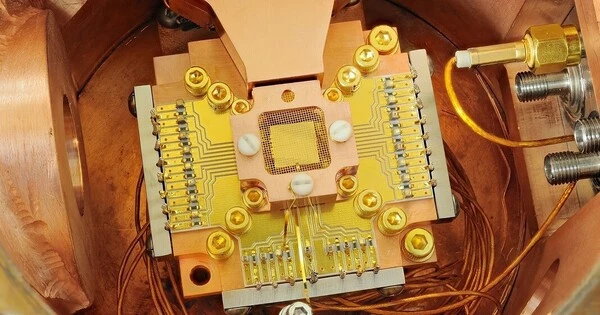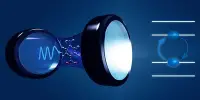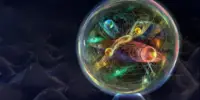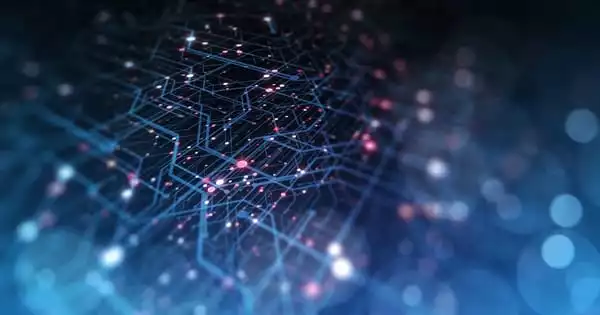A precision diagnostic developed at the Department of Energy’s Sandia National Laboratories is quickly becoming the gold standard for detecting and describing problems within quantum computing hardware.
Two papers published in the scientific journal Nature describe how separate research teams, one of which included Sandia researchers, developed and validated highly reliable quantum processors using a Sandia technique called gate set tomography. Since 2012, Sandia has been developing gate set tomography with funding from the DOE Office of Science’s Advanced Scientific Computing Research program.
One of today’s papers was co-authored by Sandia scientists and Australian researchers from the University of New South Wales in Sydney, led by Professor Andrea Morello. They used GST to demonstrate that a sophisticated three-qubit system in a silicon chip comprised of two atomic nuclei and one electron could be manipulated reliably with 99 percent -plus accuracy.
Another group led by Professor Lieven Vandersypen of Delft University of Technology in the Netherlands used gate set tomography, implemented with Sandia software, to demonstrate the important milestone of 99 percent -plus accuracy, but with a different approach, controlling electrons trapped within quantum dots rather than isolated atomic nuclei.
“We want researchers around the world to know they have access to a powerful, cutting-edge tool that will assist them in making breakthroughs,” said Sandia scientist Robin Blume-Kohout.
We want researchers around the world to know they have access to a powerful, cutting-edge tool that will assist them in making breakthroughs. Sandia’s theoretical and computational methods enabled the rigorous demonstration of quantum computing with greater than 99 percent fidelity, as well as valuable insights into the microscopic causes of residual errors. We intend to broaden this strategic collaboration in the coming years.
Robin Blume-Kohout.
Future quantum processors with many more qubits, or quantum bits, could allow users in national security, science, and industry to perform some tasks faster than a conventional computer ever could. However, flaws in current system controls result in computational errors. A quantum computer can correct some errors, but the more errors it has to correct, the larger and more expensive the computer is to build.
As a result, scientists require diagnostic tools to determine how precisely they can control single atoms and electrons that store qubits and to learn how to prevent errors rather than correct them. This improves the system’s reliability while lowering costs.
Sandia’s flagship technique for measuring the performance of qubits and quantum logic operations, also known as “gates,” is gate set tomography. It combines the results of various measurements to generate a detailed report that describes every error that occurs in the qubits. Morello and other experimental scientists can use the diagnostic results to determine what needs to be fixed.
“The Quantum Performance Laboratory at Sandia National Labs, led by Robin Blume-Kohout, has developed the most accurate method to identify the nature of the errors occurring in a quantum computer,” Morello said.

Gate set tomography even detects unexpected error
The Sandia team maintains a free, open-source GST software called pyGSTi (pronounced “pigsty,” which stands for Python Gate Set Tomography Implementation). Publicly available at http://www.pygsti.info, it was used by both research groups publishing in Nature today.
The Delft team used the pyGSTi software without help from the Sandia team, whereas the UNSW-Sandia collaboration used a new, customized form of gate set tomography developed by the Sandia researchers. The team was able to rule out more potential error modes and focus on a few dominant error mechanisms thanks to the new techniques. However, when the Sandia team examined the GST analysis of the UNSW experimental data, they discovered an unexpected type of error that Morello’s group had not anticipated. When the nuclear-spin qubits should have been isolated, they were interacting.
Concerned that this error might indicate a flaw in the qubits, the team turned to Sandia’s Andrew Baczewski, an expert in silicon qubit physics and a researcher at the Quantum Systems Accelerator, a National Quantum Information Science Research Center, to help find its source.
“It came to occupy a large portion of my free time,” Baczewski explained. “I’d be out for a walk on a Saturday morning when something would occur to me, and I’d run home and do math for an hour.”
Baczewski and the rest of the team eventually traced the error back to a signal generator that was leaking microwaves into the system. Now that the cause has been identified, this can be easily corrected in future experiments. “It was really satisfying to see confirmation that GST even detected the errors that nobody expected,” Blume-Kohout said.
“Collaboration with Sandia National Laboratories was critical in achieving the milestone of high-fidelity quantum operations in silicon,” Morello explained. “Sandia’s theoretical and computational methods enabled the rigorous demonstration of quantum computing with greater than 99 percent fidelity, as well as valuable insights into the microscopic causes of residual errors. We intend to broaden this strategic collaboration in the coming years.”
















